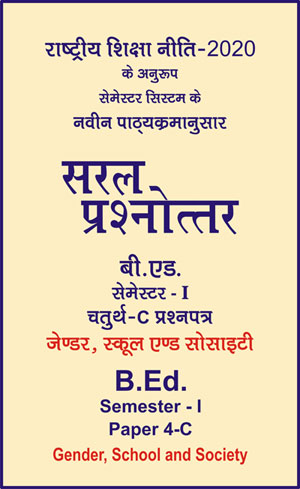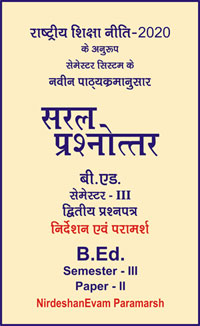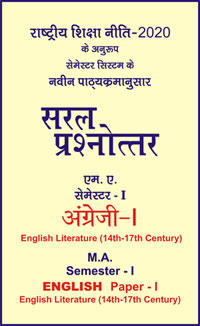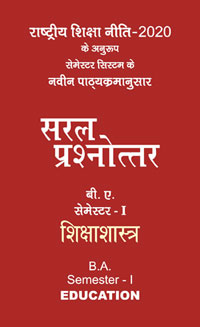|
बी एड - एम एड >> बी.एड. सेमेस्टर-1 प्रश्नपत्र-IV-C - जेण्डर, स्कूल एण्ड सोसाइटी बी.एड. सेमेस्टर-1 प्रश्नपत्र-IV-C - जेण्डर, स्कूल एण्ड सोसाइटीसरल प्रश्नोत्तर समूह
|
|
||||||
बी.एड. सेमेस्टर-1 प्रश्नपत्र-IV-C - जेण्डर, स्कूल एण्ड सोसाइटी (अंग्रेजी भाषाा में)
UNIT-3 : Gender, Power and Education
Chapter 9 - Gender identities and Socialization Practices in Family, School and Other Formal and Informal Organisations
Question-How are self, identity and society related to each other?
Related Short Answer Questions
-
What do you understand by ‘Self’? Tell in brief.
-
Where is gender inequality prevalent?
Answer -
The concepts of self and identity have been widely discussed and different definitions have been given and clarified in different disciplines of social sciences. The conscious, subjective personality of the individual in its entirety may be called the self and the distinctive personality of an individual which is considered to be a permanent existence may be called the identity. The issues of self and identity are frequently used in symbolic interactionist theories. According to interactionist theorists, self reflects society, which means society gives form to self, which again gives shape to social behaviour. For them, society and religion are disorganized, unitary and unstable. However, structural symbolic interactionists see society as a highly differentiated but organized system of interactions and relationships, within whose periphery, there are various dividing lines based on social class, age, gender, race, religion, customs, etc. The Self is seen as having many aspects because it consists of a variety of parts that are sometimes interdependent and sometimes independent of other parts, sometimes conflicting, and they exist in many ways. Each part is an identity created out of the self, based on role expectation. Thus, the self is conceived as a set of distinct identities or internal role designations. For example, the existence of a particular gender, caste, race, class, etc. and the role expectancy associated with each identity is the totality of the set of identity itself. By this, we understand that identity is a self-realization bound by roles and status in social relationships organized through these roles.
It has also been argued that there is a difference in the emergence of identity. That is, calling a given identity in a variety of circumstances or it can be defined as a differential probability. Thus, the choice between behaviours that express particular roles reflects the relative location of the identities associated with those roles. (Dibal Singh Rai 2004).
It is argued that the individual self and identity are socially constructed. As individuals living in a society, we conceive or construct our social identity along with various social processes or phenomena on the basis of our observations and experiences, our interactions with other people of other societies. The sense of community and fraternity are closely related to the idea of social identity of the individual self (Sen CF, Singh Rai 1999). There is a strong influence of the community and the people with whom the individual self associates and associates itself (the same). Gender in that sense (accepting oneself as a female or male gender and the roles and expectations associated with that gender) is a social identity of an individual as an identity, created primarily by his/her social interactions and is influenced by the community. Philosophically, identity is not universal but is a culture-specific incompatible construct and cultural identities are constructed continuously (Hall 1990). This means that gender identity is a culturally distinct and socially constructed structure that varies over time and space.
Gender inequality exists in most societies, meaning differences and inequalities in the roles and responsibilities assigned to women and men, the activities they perform and the availability of resources and control over them, and the opportunities to make decisions. There is a difference in the magnitude of gender discrimination and gender inequality in every society and it depends on the nature of the specified gender role in that particular society.
Question- Throw light on the gender division of labour in family and household. How does it determine gender role?
Related Short Answer Questions
-
What functions does the family fulfil as a fundamental institution?
-
What responsibilities does the gender division of labour in the household represent for women?
Answer -
Family and household are one of the most fundamental institutions of society. It is a major site of gender-based composition and gender discrimination. The structure of the family institution, whether it is nuclear or joint, has been done on the dimensions of age, kinship or fraternity and most importantly gender. As a fundamental institution of society, the family performs certain important functions such as - (a) regulation and orderly performance of sexual relations, (b) nurturing and nurturing the younger generation and teaching values, (c) economic production and the distribution of such product, (d) the establishment and maintenance of interrelationships among larger kin groups that link individual families to the community and society, (e) legitimizing inheritance. It is believed that the family serves the purpose of mutuality of interests, lack of individualism, a sense of jointness in generous sharing of workloads and essential daily tasks, and interdependence and security. However, feminists see this as an aspect that hides the truth of the oppressive structure, which helps to maintain the boundaries of this institution and ensure its proper functioning. According to him, the division of roles and responsibilities, allocation of resources and distribution of authority which actually exists in the family and household, are gender based and give women an inferior status.
In society, women and men are assigned different productive work on the basis of their gender identity. This gender discrimination in the allocation of work is justified given that women and men have been given separate and equal areas of work, such as earning bread for men and housekeeping for women. This signifies that every socially specified task will be recognized with equal priority. However, in practice, acts assigned to men and women are associated with unequal status in which the actions of one group are glorified while the other is not recognized. In many societies, women’s work areas have been devalued and gender-specific jobs have been degraded, with men’s jobs given high status and women’s jobs low. An examination of gender specific functions performed by the two genders will shed more light on this subject.
The responsibilities that the gender division of labour in the household represents for women largely revolve around the need for reproduction, parenting, child care, and socialization while men have to earn. If equal status is given to separate areas of activity, then the distribution of resources within and outside the household will also be equal. As we know and various studies have proved, the distribution of resources within the household is unequal. Women regularly get less respect than men. Not only this, the separation of areas into ‘public’ and ‘private’ also provides for inferior status and lack of recognition. The major part of production activities in the household for women comes in the private sector. Barrett (1988), in a study on gender construction and the gender division of labour in capitalist societies, shows that women have full responsibility for household chores and child care and it is a responsibility that is unpaid and whose value has also been underestimated. The stereotyped image of women’s responsibility is also visible in the labour market.
Traditionalists, who support the gender division of labour in the family in its present form, argue that it is natural, divine, complementary and purposive, and even essential for the continuation of the human race. For him, the biological frailty of women has been the basis of social institutionalization of difficult tasks for men and simple household chores for women. This dichotomy in terms of difficult and easy tasks has made women’s work insignificant and consequently their work has been devalued and it has made the legend memorable that women do not do those tasks which require hard manual labour, may or may not engage in those tasks. The hard back breaking work that women can do is denied and the work that women can do, is considered of little value.
Thus, the hierarchy of gender roles institutionalized through the family system actually creates inconsistencies in gender roles and expectations and leads to the exploitation of women by men in the family and society. This gender-themed role classification considers men's actions to be truly human and conscious, rational, planned and productive, and sees women's domestic and child-care tasks as extensions of their physiology and hence are not seen as actual work.
There is a discrepancy in gendered roles, in which patriarchal families assign higher values to boys than girls and to men over women. Not only this, it also determines the resources such as food, education, property, leisure and even space for both women and men. Inequality in the availability of resources important for physical and mental health, on the one hand, determines the different foundations for the lives of men and women, and on the other, creates genders in such a way that men are decision-makers and power while women have no direct control over their personality and body. Powerlessness affects women in such a way that they show signs of isolation, low self-esteem, lack of self-confidence, ignorance, apathy, dependence and passive acceptance.
|
|||||

 i
i 









